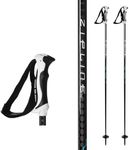Buying Guide for the Best Downhill Ski Poles
Choosing the right downhill ski poles is essential for enhancing your skiing experience. The right poles can help with balance, timing, and rhythm while skiing. When selecting ski poles, it's important to consider several key specifications to ensure they meet your needs and preferences. Here are the key specs to look out for and how to navigate them.LengthThe length of ski poles is crucial because it affects your balance and control while skiing. To find the right length, stand the pole upside down with the grip on the floor and hold it just under the basket. Your elbow should be at a 90-degree angle. If you ski more aggressively or in deeper snow, you might prefer slightly longer poles for better leverage and stability.
MaterialSki poles are typically made from aluminum, carbon fiber, or composite materials. Aluminum poles are durable and affordable, making them a good choice for beginners. Carbon fiber poles are lighter and offer better performance, ideal for intermediate to advanced skiers. Composite poles offer a balance between durability and weight, suitable for a wide range of skiers. Choose the material based on your skiing level and how much weight matters to you.
GripThe grip of the ski pole is where you hold it, and it should be comfortable and secure. Grips come in various materials like rubber, foam, or cork. Rubber grips are durable and provide a good grip, foam grips are lightweight and comfortable, and cork grips offer excellent comfort and insulation. Consider how the grip feels in your hand and how it performs in different weather conditions.
StrapThe strap on a ski pole helps keep the pole attached to your hand, providing better control and reducing the risk of losing the pole. Straps can be adjustable or fixed. Adjustable straps allow for a customized fit, which can be more comfortable and secure. Fixed straps are simpler but may not offer the same level of comfort. Choose a strap that feels secure and comfortable for your hand size and skiing style.
BasketThe basket is the circular piece near the bottom of the pole that prevents it from sinking too deep into the snow. Baskets come in different sizes: smaller baskets are better for groomed slopes, while larger baskets are ideal for powder and off-piste skiing. Choose the basket size based on the type of terrain you ski on most frequently.
Shaft DiameterThe shaft diameter of a ski pole affects its strength and weight. Thicker shafts are generally more durable and can withstand more force, making them suitable for aggressive skiing. Thinner shafts are lighter and can be easier to handle, which might be preferable for less intense skiing. Consider your skiing style and how much you value durability versus weight.




















